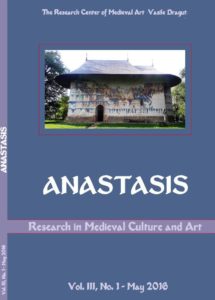Peintures du sanctuaire et de la nef de l’Eglise de La Décollation de St Jean Baptiste du village d’Arbore
Paintings of the sanctuary and nave of the Church “The Beheading of St John the Baptist” from Arbore Village
Author(s): Tereza SinigaliaSubject(s): Architecture, Visual Arts, Eastern Orthodoxy
Published by: Editura ARTES
Keywords: Arbore village; Luca Arbore’s family; mural painting; Dragosin/Dragoş Coman; iconographic program
Summary/Abstract: The paper presentstwo main aspects regarding the inside murals of the church in the villageArbore (Suceava county), whose restoration process will be finished nextyear. The church is a foundation of the great chef of the Moldavian armyduring the reigns of Stephen the Great, Bogdan III and of the first years ofStephen’s the Younger, Luca Arbore, from 1503. The first aspect regards thedisputed problem of the author of the murals and of the moment of theirrealization. The starting point of the discussion is the information given by aninscription painted in the inner side of the enter arch to the nave: it gives thename of a painter “Dragosin son of pan Coman of Iasi” and the year 1541. Asthe inscription was painted in a light tempera technique and disappearedduring the 50 years since its discovery. The author presents a other point ofview, based on the analysis of the persons of Arbore family represented in thefuneral and in the votive paintings in the church (number of children, theirage, style), both of them conserving traces of vandalism and important repaintingsof the great damaged surfaces. Having in mind the dedication of thechurch “ Beheading of St John the Baptist” and the large cycle of his vitapainted on the eastern wall of the narthex, as it was the custom duringStephen’s the Great reign (Pătrăuţi, Voroneţ, St Elie –Suceava, St Nicolas /Botoşani, St Nicolas – Bălineşti), corroborated with the stylistic analysis, Iproposed to accept two phases for the realization of the murals: the first oneduring the founder’s life († 1523) with an anonymous chef of the paintersteam, and the second one attributed to Dragosin/Dragoş Coman, author onlyof the repair of the damages caused by the Ottomans in 1538 war.The second aspect regards the restitution of the iconographic program of thecupola, the chancel and the nave, with its peculiarities, new themes or newartistic solutions for the traditional ones.
Journal: Anastasis Research in Medieval Culture and Art
- Issue Year: III/2016
- Issue No: 1
- Page Range: 5-75
- Page Count: 71
- Language: French

